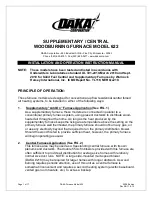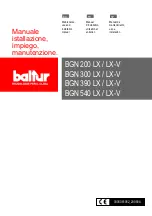
Page 3 of 17
DAKA Furnace Model 622
2008 Edition
Rev 2B: 11-9-12
9. These furnaces have been designed to operate with a maximum warm air duct
pressure of 0.2" water column and a maximum warm air duct temperature of
200°F. When used in a supplementary "add-on" mode, check the nameplate on
the primary furnace to determine compatibility.
10. When any supplementary furnace is connected in parallel to an existing primary
central furnace, a back-draft damper must be installed in the plenum of the
primary furnace below the warm air inlet from the supplementary furnace to
prevent the primary furnace from operating in an unintended manner. See FIG. 1
for an illustration of the position of this damper.
11.
IMPORTANT: WHETHER INSTALLED AS A SUPPLEMENTARY/ADD-ON OR
CENTRAL FURNACE, INSTALLATION OF A COLD AIR RETURN LINE IS
MANDATORY.
DANGER
– RISK OF FIRE OR EXPLOSION! DO NOT BURN GARBAGE, GASOLINE,
DRAIN OIL OR OTHER FLAMMABLE LIQUIDS.
WARNING
– RISK OF FIRE! DO NOT OPERATE WITH FLUE DRAFT EXCEEDING
.06" WATER COLUMN. DO NOT OPERATE WITH FUEL LOADING OR
ASH REMOVAL DOORS OPEN. DO NOT STORE FUEL OR OTHER
COMBUSTIBLE MATERIAL WITHIN MARKED INSTALLATION
CLEARANCES. INSPECT AND CLEAN FLUES AND CHIMNEY
REGULARLY.
CAUTION
– HOT SURFACES! KEEP CHILDREN AWAY. DO NOT TOUCH DURING
OPERATION. MAXIMUM DRAFT MARKED ON NAMEPLATE.
Disposal of Ashes
Ashes should be placed in a metal container with a tight-fitting lid. The closed container
of ashes should be placed on a non-combustible floor or on the ground, well away from
all combustible materials, pending final disposal. If the ashes are disposed of by burial
in the soil or otherwise locally dispersed, they should be retained in the closed container
until all cinders have thoroughly cooled.
Creosote
– Formation and Need for Removal
When wood is burned slowly, it produces tar and other organic vapors, which combine
with expelled moisture to form creosote. The creosote vapors condense in the relatively
cool chimney flue of a slow-burning fire. As a result, creosote residue accumulates on
the flue lining. When ignited this creosote makes an extremely hot fire.
The chimney connector and chimney should be inspected at least twice monthly during
the heating season to determine if a creosote buildup has occurred. If creosote has
accumulated it should be removed to reduce the risk of a chimney fire. Use of a smoke
vent thermometer to monitor stack temperature is recommended.



































